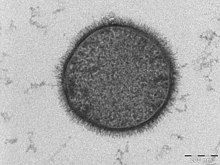This article has multiple issues. Please help improve it or discuss these issues on the talk page. (Learn how and when to remove these messages)
|
| Bacillus subtilis | |
|---|---|

| |
| TEM micrograph of a B. subtilis cell in cross-section (scale bar = 200 nm) | |
| Scientific classification | |
| Domain: | Bacteria |
| Phylum: | Bacillota |
| Class: | Bacilli |
| Order: | Caryophanales |
| Family: | Bacillaceae |
| Genus: | Bacillus |
| Species: | B. subtilis
|
| Binomial name | |
| Bacillus subtilis (Ehrenberg 1835)
Cohn 1872 | |
| Synonyms | |
| |
Bacillus subtilis (/bəˈsɪl.əs subˈtiː.lis/),[3][4] known also as the hay bacillus or grass bacillus, is a gram-positive, catalase-positive bacterium, found in soil and the gastrointestinal tract of ruminants, humans and marine sponges.[5][6][7][8] As a member of the genus Bacillus, B. subtilis is rod-shaped, and can form a tough, protective endospore, allowing it to tolerate extreme environmental conditions. B. subtilis has historically been classified as an obligate aerobe, though evidence exists that it is a facultative anaerobe. B. subtilis is considered the best studied Gram-positive bacterium and a model organism to study bacterial chromosome replication and cell differentiation. It is one of the bacterial champions in secreted enzyme production and used on an industrial scale by biotechnology companies.[5][6][7]
- ^ Euzéby JP (2008). "Bacillus". List of Prokaryotic names with Standing in Nomenclature. Retrieved 2008-11-18.
- ^ Ambrosiano N (1999-06-30). "Lab biodetector tests to be safe, public to be well informed". Press release. Los Alamos National Labs. Archived from the original on September 21, 2008. Retrieved 2008-11-18.
- ^ "How to pronounce bacillus". Cambridge Dictionary.
- ^ "subtilis". Wiktionary. 10 March 2023.
- ^ a b Errington J, Aart LT (May 2020). "Microbe Profile: Bacillus subtilis: model organism for cellular development, and industrial workhorse". Microbiology. 166 (5): 425–427. doi:10.1099/mic.0.000922. PMC 7376258. PMID 32391747.
- ^ a b Cite error: The named reference
Paul_2021was invoked but never defined (see the help page). - ^ a b Cite error: The named reference
Rahman_2020was invoked but never defined (see the help page). - ^ Paul SI, Rahman MM (October 2022). Gill SR (ed.). "Draft Genome Sequence of Bacillus subtilis YBS29, a Potential Fish Probiotic That Prevents Motile Aeromonas Septicemia in Labeo rohita". Microbiology Resource Announcements. 11 (10): e0091522. doi:10.1128/mra.00915-22. PMC 9583808. PMID 36154193.